|
LEM295 DXpedition to Lemmenjoki
October 23-30, 2010
By Mika
Mäkeläinen
The second
leg of our two-part DXpedition began in a very sad
way; our landlady Kristiina Jomppanen had passed
away just two days earlier at the age of 90. Her
sons reassured us that we would nevertheless be
most welcome, and that they will be happy to host
DXers also in the future. DXing didn't offer much
consolation. Solar weather was unfavorable, and
conditions began to improve only just before we
had to leave.
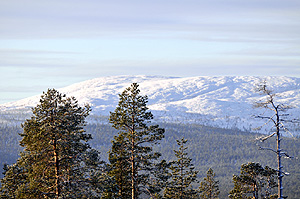
Joenkielinen fell mountain
in the Lemmenjoki National Park, seen from the
end of our Beverage antennas (you can click
on the photos to open a larger photo in a new
browser window) |
I had already
been DXing in Aihkiniemi
for a week, when on Saturday, October 23, I packed
everything, and headed to Ivalo in a fierce snow
storm. Jim Solatie
flew from Helsinki to Ivalo, where we shopped for
groceries, and proceeded to Lemmenjoki.
We expressed our condolences to Kristiina's four
sons and talked a bit about the past and about the
future. Kristiina had hosted DXers here since the
1980's, and thanks to her hospitality, Lemmenjoki
has become by far the most well-known DXing location
in Finland. Moreover, Lemmenjoki is probably the
most visited DXpedition site in the entire world,
judging by the number of DXpeditions held there,
ours being DXpedition number 295! The listening
base will now be moved from the small red cabin
to Kristiina's former home, but since it will involve
rebuilding the coax feed lines, this change won't
take place before next summer.

Hazy future |
DXing began in a
disappointing way. We missed the afternoon conditions
to the Pacific and Asia while setting up the equipment,
and a neighbor's electrical fence destroyed whatever
was left on the AM band. Later, we thought we had
arrived at an agreement about keeping the fence
off the grid during the most important daytime DX
sessions, but by midweek the fence returned on the
air, and so we had to keep on switching it on and
off by ourselves. We were lucky: the two horses
held back by the fence did not seize the chance
to escape.
Overall, conditions
to Asia continued almost as good as they were during
the previous week. Once the Earth's magnetic field
began to recover from the effects of a coronal hole
that took down long-distance AM reception in the
beginning of the DXpedition, conditions to the Western
Hemisphere began to improve as well. I noticed Northern
lights only once, on Wednesday, October 27.
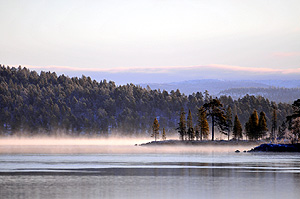
Kuivajärvi freezing
on a cold morning |
Conditions straight
north were much better than average, so Hawaiians
were a daily joy, and I was happy to log RFO Tahiti
on 738 kHz for the first time. In this respect it
was great to have an antenna pointing straight north,
as a similar antenna was still in the planning stage
in Aihkiniemi.
However, we knew that an antenna pointing at 30
degrees was better in Aihkiniemi than in Lemmenjoki,
so we left unattended recordings in Aihkiniemi for
the duration of our DXpedition in Lemmenjoki. Eventually
we ended up driving back and forth to Aihkiniemi
(120 km/75 miles one way) every other day, because
our timed recording attempts were not very successful.
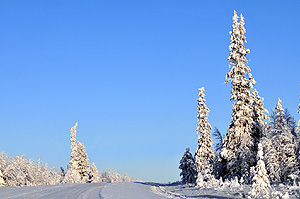
This is almost the northernmost
point where spruce still grows |
Initially non-existent
nighttime conditions improved slightly towards the
end, and generally conditions to the U.S. were best
on departure day. We didn't immediately notice any
truly sensational catches from any direction, but
the amount of our recordings is once again so vast
that I'm convinced there will be some really neat
surprises. The end of October tends to be a popular
timing for AM DXpeditions, so it was no surprise
that fellow hobbyists were active as well. It will
be interesting to compare what was heard at the
time in Parkalompolo, Sweden, on PAX87
DXpedition.
Here's a listing
of solar weather indices, followed by a description
of reception conditions each day:
| Date |
Mea-sured
solar
flux |
Sunspot
number |
Planetary
A index |
K
indices (3-hour intervals) |
Min-max
solar
wind speed (km/sec) |
Number
of flares (events) |
ST
AR |
NO
AA |
ST
AR |
NO
AA |
Daily low - high |
Planetary |
Boulder |
C |
M |
X |
| 23.10.2010 |
84.3 |
54 |
43 |
23.1 |
23 |
7-48 |
32445424 |
42444424 |
479-686 |
|
|
|
| 24.10.2010 |
85.0 |
42 |
34 |
1.4 |
1 |
0-4 |
10000010 |
10001110 |
271-277 |
1 |
|
|
| 25.10.2010 |
86.2 |
93 |
57 |
5.9 |
6 |
3-12 |
21112131 |
11222122 |
548-662 |
1 |
|
|
| 26.10.2010 |
86.1 |
70 |
74 |
7.6 |
8 |
3-15 |
32221222 |
32331221 |
495-640 |
2 |
|
|
| 27.10.2010 |
87.6 |
46 |
53 |
4.1 |
4 |
0-9 |
11101022 |
11212121 |
465-553 |
1 |
|
|
| 28.10.2010 |
86.4 |
44 |
27 |
2.9 |
3 |
2-5 |
00001111 |
10112210 |
379-471 |
|
|
|
| 29.10.2010 |
83.7 |
50 |
24 |
3.1 |
3 |
0-6 |
11001200 |
21102200 |
348-388 |
|
|
|
| 30.10.2010 |
84.8 |
35 |
32 |
2.1 |
2 |
0-7 |
00011200 |
00011301 |
347-421 |
|
|
|
| 31.10.2010 |
81.2 |
36 |
32 |
3.3 |
3 |
0-6 |
02012001 |
02122111 |
344-364 |
2 |
|
|

Jim DXing at sunset |
Sunday, October 24, 2010
We patiently waited for a trans-Atlantic opening,
and got just scattered signals from Brazil and North
America all through the night. The morning was especially
poor: North American stations were heard for less
than half an hour, until everything vanished at
0610 UTC, the worst morning in over a week. In the
daytime there was ample time to catch up on sleep,
maintain equipment and listen to the recordings.
In the afternoon Asians arrived remarkably late,
for real only around 1400 UTC, but fortunately they
also dominated the dial exceptionally late. We recorded
a band full of robust signals from China and Taiwan,
and to a small extent from elsewhere in South-East
Asia until 1600 UTC.
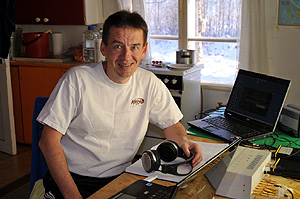
Mika listening in the
afternoon |
Monday, October 25, 2010
Overnight was thoroughly lousy,
with Brazilian Rádio Globo on 1220 kHz as
one of the few stations producing a decent signal.
In the morning conditions were interesting at 0500-0600
UTC when stations from the Rockies and the Caribbean
made brief inroads into our cabin. What followed
was another quiet day and very good conditions towards
China at 1300-1500 UTC, but we didn't instantly
notice any rarities.
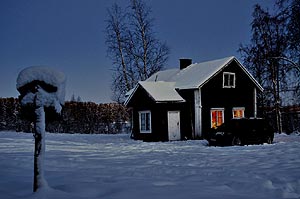
My last DXpedition in
this old cabin |
Tuesday, October 26, 2010
Overnight was once again a disappointment,
although there were minor bursts of stations from
both South and North America. Morning action focused
on South America at 0500-0600 UTC, when we experienced
excellent conditions towards Argentina, Uruguay
and Brazil, and relatively hefty signals also from
the Northern half of South America. Identified stations
include Radio Argentina from Buenos Aires on 570.031
kHz and Rádio Eldorado from São Paulo
on 700 kHz. The AM band fell silent after 0600 UTC,
although there was a short-lived burst of signals
from the Rockies at 0805-0825 UTC. There was a long
silence on the band before the usual suspects from
the Pacific Northwest appeared around 1300 UTC for
an hour, along with the most common stations from
Alaska and Hawaii. Asians emerged at the same time,
but lasted longer, although by 1430 UTC stations
from Europe and the Middle East gradually took over.
Compared to previous days, conditions favored a
more Southern area, and there were many stations
from the Indian subcontinent.
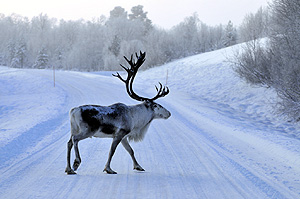
Reindeer crossing |
Wednesday, October 27, 2010
North American stations emerged
out of the static around 0130 UTC, which was a happy
surprise after several practically dead nights.
North American signals, focused in the Rockies,
peaked around 0300-0600 UTC, and daylight hours
were mostly quiet. Also South American stations
were strong in the early morning hours, peaking
at 0500-0600 UTC, with a few nice catches from Peru
and the Caribbean just before everything vanished
(stations like Radio Turbomix from Cajamarca, Peru,
on 1540 kHz, and RCN Manizales from Colombia on
1450 kHz with a local station ID). In the afternoon
Hawaiian stations were heard for hours, at best
stronger than I have probably ever heard them before,
but finding new ones was still quite a struggle.
The Pacific Northwest made a brief appearance around
1300 UTC. Asian stations made their way here starting
after 1230 UTC, focusing initially on China, but
later conditions spread thinly all over, with random
Indians and Iranians in the mix.
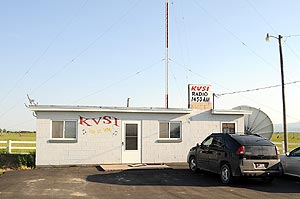
KVSI, now both seen and
heard |
Thursday,
October 28, 2010
Once again no daytimers, so we
let automated recordings supervise the AM band through
the night. It seems that conditions to North America
were somewhat better than before. As customary,
daybreak at 0500-0600 UTC was the most interesting
period, when keeping track of the direction of propagation
conditions was a fulltime task. Around 0600 UTC
we heard a bunch of Cubans and for example WWFE
Miami FL on 670 kHz. Later on signal levels subsided
a bit, but the stations did not vanish, as they
had been doing for the previous five days. During
the daytime reception of U.S. West Coast varied
from average to excellent. 1450 kHz, which is the
toughest graveyard frequency, was audible better
than I have heard ever before. We were able to identify
for instance KVSI Montpelier, Idaho, a station that
I happened to photograph on a family road trip through
the Rockies in midsummer 2008. We were driving from
Salt Lake City to Yellowstone, and stayed overnight
in Montpelier. KVSI is located right on the main
road. Now I've both seen and heard it! And a few
days later we continued to Glacier National Park
in Montana, where we shared a cabin with Jim's family
for a week of hiking. It was a memorable trip, but,
now back to 2010. RFO Tahiti on 738 kHz and quite
a few Hawaiians showed up around 0800 UTC. The first
Japanese tried to emerge at 1030 UTC, but then at
1115 UTC almost everything-from both the East and
the West-just disappeared. Eventually Asians returned
before 1300 UTC, and we got a full couple of hours
of mostly Chinese stations.

On the scenic road from
Lemmenjoki to Kittilä |
Friday, October 29, 2010
North American stations were
audible through the night from around 2300 UTC,
with emphasis on the Midwest and the Rocky Mountains.
It remains to be seen what our drift net recordings
caught from Latin America overnight, but at least
some Venezuelan stations were heard rather well
in the morning after 0500 UTC. The Rockies and the
U.S. West Coast remained strong late in the morning,
although there unfortunately weren't any sharp changes
or clear focus in the nature of propagation conditions
like on the previous morning. We spent the daylight
hours travelling to and from Aihkiniemi, and when
we arrived just before 1300 UTC, the Pacific Northwest
was heard with monster signals. Also Hawaii and
Alaska came quite well for a moment right after
1300 UTC. Asian stations were still quite weak,
but by 1400 UTC Chinese stations were extremely
strong and occupied almost every AM frequency. Although
Chinese stations gradually lost the fight by 1600
UTC, they made a forceful and surprising comeback
before 2100 UTC, well before local dawn.
Saturday, October 30, 2010
Overnight conditions to North
America were above average, and by midday trans-Atlantic
stations were stronger than on any previous day
during the past two weeks —tough luck, as it
was our departure day, and we had to vacate the
cabin shortly after midday. We drove in crisp and
sunny weather for three hours down to Kolari, where
we caught a train back home. LEM295 was perhaps
not a major success in terms of new stations heard,
but still worth the trip and a lot of fun, as always.
Published
on November 12, 2010
  
|